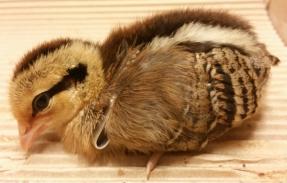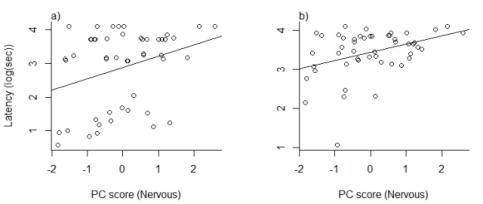Results of personality influences

Through the behaviours obtained from the personality tests four personality gradients were detected using statistics (a principal component analysis). These gradients detected were "activeness", "fearfulness", "escape proneness" and "nervousness". From these gradients each chick got an individual score which was used to investigate correlations with mean latencies to reach each cue in the cognitive judgment bias test.
Only one correlation was significant, and this was when investigating correlation with the nervousness gradient. Furthermore, when investigating each cue on its own, only the unrewarded cue and the intermediate cue close to it correlated with the nervousness score (figure 1). This means that chicks displaying a higher amount of "nervous behaviours" are more pessimistic towards unrewarded cues and ambiguous cues resembling it.
However, the nervousness gradient only explained 9,4 % of the variation in personality data, meaning that only a limited amount of the reactions in the cognitive judgment bias test can be explained by personality.
The reason why only a small part of the cognitive judgment bias was explained by personality after environmental factors was minimized is not easy to understand. Perhaps personality do not have a big part in why we judge the surrounding the way we do, or perhaps personality and / or cognitive judgment bias are more complex than I have been able to study in this experiment. Thus more extensive studies or studies using different types of tests might give more information about the connection between cognitive biases and personality.

Responsible for this page:
Director of undergraduate studies Biology
Last updated:
05/05/15
